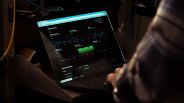The brain has a way of seeing things that aren't really there, a way of taking random patterns and putting them into order to create a familiar shape.
This explains why we see a man in the moon, the Virgin Mary on a grilled cheese sandwich and, most recently, a coffin on the surface of Mars in a photo taken by the Mars Curiosity rover. And it's something we all do.
"If you take a baby just after a few minutes of life, he will direct his attention toward something that has the general features of a face versus something that has the same elements but in a random order," says Dr Nouchine Hadjikhani of Harvard University.
This phenomenon, called pareidolia, is something that happens often in the human brain, which basically means we make sense of the random by envisioning it as something familiar. And it's something we learned early on, as a species, and is part of our evolutionary history.
In 1995, American cosmologist Carl Sagan, attributed this recognition of familiar objects and faces as an early survival technique. For example, if one of our early ancestors saw a shape standing at the top of a hill, that shape could be either a rock or a predatory animal. Seeing that shape as a predatory animal, regardless of its true nature, resulted in the ancestor running, possibly saving a life.
A study published in 2010 suggests that identifying faces and familiar objects in something random helps us understand it. That study determined that our brains understand non-face objects as quickly as face objects, perhaps because of how we see them as faces.
Psychologists use this innate ability with the Rorschach inkblot tests, which is a series of random inkblot patterns painted onto cards. Psychologists gain insight into the minds of their patients by asking them what faces and/or objects they see when viewing the cards.
However, many people believe the things they see when pareidolia kicks in. For example, when a recent image from the Mars Curiosity rover showed an object that resembled a coffin, the image became one of the most shared photos on social media and conspiracy theorists started speculating about the existence of aliens on the red planet.
Unfortunately, it's unlikely that the shape in the image is a coffin or that E.T. will start popping up in Curiosity's selfies. But that knowledge doesn't stop those who truly believe in what they see.
"In reality, UFO enthusiasts just spend far too much time searching Nasa images for the slightest glimpse of anything weird and finding proof that fits their own ideas," says Nigel Watson, author of the UFO Investigations Manual. "In addition to the discovery of this coffin, way back in March 2014 'Truthseeker' posted on Youtube a picture taken by the Curiosity rover that seemed to show a cross, which he thought was connected to a religious ceremonial religious structure."
So the next time you make toast and see the President's face, just remember, it's probably just pareidolia.
ⓒ 2025 TECHTIMES.com All rights reserved. Do not reproduce without permission.




